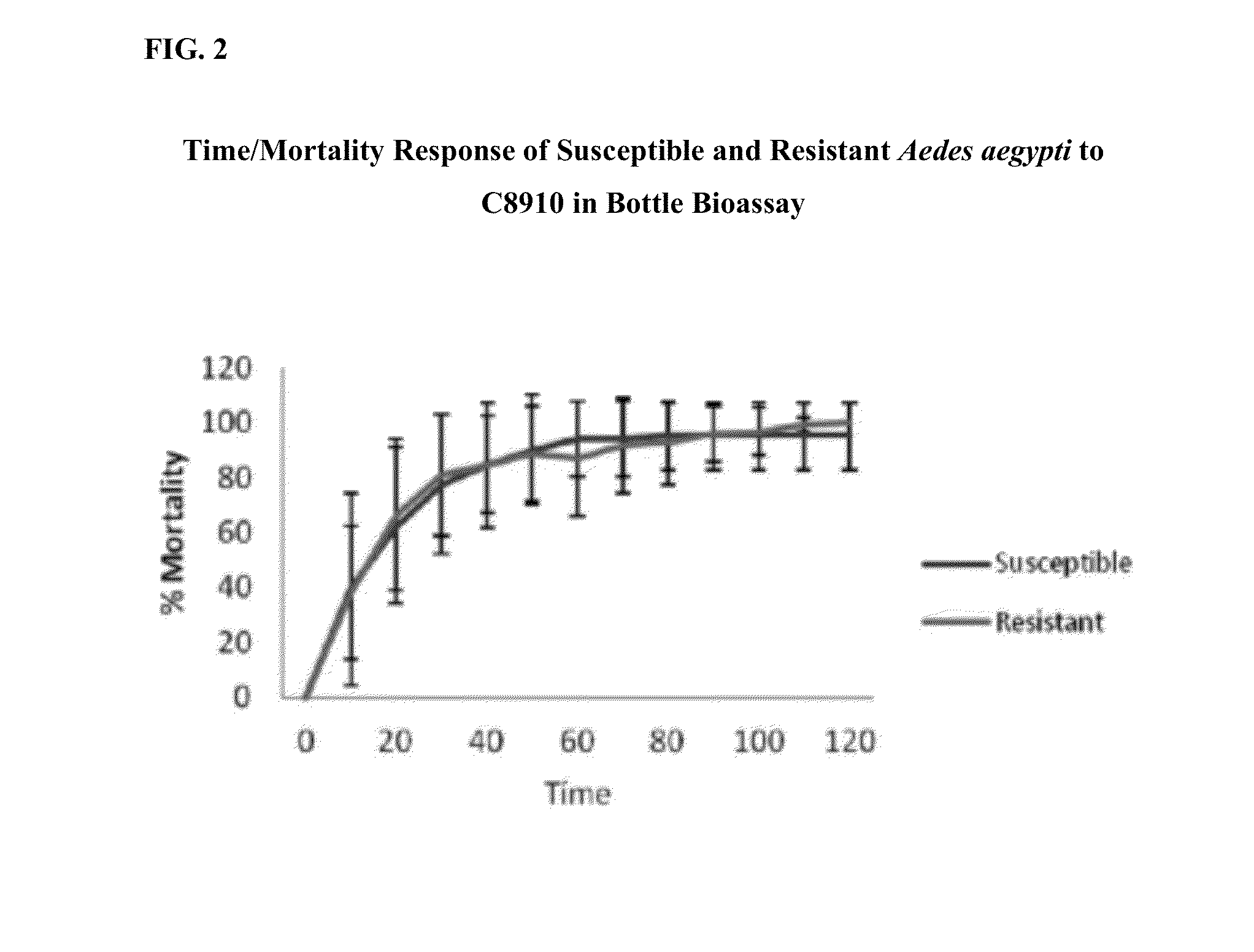Octanoic, nonanoic and decanoic fatty acids with a pyrethroid adulticide
a technology of octanoic which is applied in the field of mix of octanoic, nonanoic and decanoic fatty acids and adulticides, can solve the problems of ineffective insecticides in their current form, population resistance of arthropods, and potentially devastating consequences for public health
- Summary
- Abstract
- Description
- Claims
- Application Information
AI Technical Summary
Benefits of technology
Problems solved by technology
Method used
Image
Examples
example 1
Formulations
[0041]Preparation of octanoic, nonanoic and decanoic fatty acid (C8, 9, 10) and permethrin mixtures.
[0042]First, a 1% permethrin in acetone solution was prepared, Solution I. This solution was then used to prepare different permethrin dilutions in Solutions II and III. Butyl Hydroxy Toluene (“BHT”) was used as an antioxidant. Solutions I, II, and III were then mixed with C8, 9, 10 as explained below.
TABLE 1Solution IOrder ofFormulation ingredient1% PermethrinWt %additionPermethrin1.21.0000% 1Acetone118.398.6%2BHT0.5 0.4%3Total Wt120.00 100%
TABLE 2Solution IIOrder ofFormulation ingredient0.1% PermethrinWt %additionSolution I12.510.0000%1Acetone11289.6000%2BHT0.5 0.4000%3Total Wt125.00 100%
TABLE 3Solution III 0.01%Order ofFormulation ingredientPermethrinWt %additionSolution II2010.0000%1Acetone179.289.6000%2BHT0.8 0.4000%3Total Wt200.00 100%
Preparation of 1% Permethrin in Acetone (Solution I; Table 1):
[0043]The above ingredients were weighed into a 250 mL bottle equip...
example 2
Bottle Bioassays
[0050]The following bioassays were performed to determine how pyrethroid susceptible and pyrethroid resistant Aedes aegypti responded to exposure to permethrin and the fatty acids mixture, separately and combined. The standard Centers for Disease Control (“CDC”) bottle bioassay method was used. The testing was conducted at Centro Internacional de Entrenamiento e Investigaciones Médicas (“CIDEIM”) in Colombia with susceptible and resistant Aedes aegypti. The compounds were diluted in acetone, added to the bottles, and bottles were rolled to coat them internally until dry. Susceptible and resistant mosquitoes were exposed inside the treated bottles.
[0051]Bottle bioassays assess susceptibility by measuring time-to-death of mosquitoes exposed in bottles coated internally with a “diagnostic concentration” of the test compound. Resistant mosquitoes will take significantly longer to be affected by contact with the material than will susceptible mosquitoes, resulting in diff...
example 3
Topical Bioassays
[0055]The following topical bioassays were performed to determine how pyrethroid susceptible and pythroid resistant Aedes aegypti responded to exposure to permethrin and the fatty acids mixture, separately and combined. The standard World Health Organization (“WHO”) topical bioassay method was used. The testing was conducted at CIDEIM with susceptible and resistant Aedes aegypti. The compounds were diluted in acetone, and 1 ul was applied to the prothorax of CO2 anesthetized mosquitoes (groups of 20—replicated 3×).
[0056]Topical bioassays focus on percent concentration delivering mortality at 24 hours, but can also assess susceptibility by measuring time-to-death of mosquitoes exposed at various concentrations. Topical assays are a closer measure of potential space spray efficacy than bottle assays, because mosquitoes receive a dose they cannot avoid (similar to spray drops).
Topical Assay #1
[0057]In this bioassay, pyrethroid susceptible and resistance mosquitoes were...
PUM
| Property | Measurement | Unit |
|---|---|---|
| area | aaaaa | aaaaa |
| residual insect | aaaaa | aaaaa |
| voltage-gated | aaaaa | aaaaa |
Abstract
Description
Claims
Application Information
 Login to View More
Login to View More - R&D
- Intellectual Property
- Life Sciences
- Materials
- Tech Scout
- Unparalleled Data Quality
- Higher Quality Content
- 60% Fewer Hallucinations
Browse by: Latest US Patents, China's latest patents, Technical Efficacy Thesaurus, Application Domain, Technology Topic, Popular Technical Reports.
© 2025 PatSnap. All rights reserved.Legal|Privacy policy|Modern Slavery Act Transparency Statement|Sitemap|About US| Contact US: help@patsnap.com



